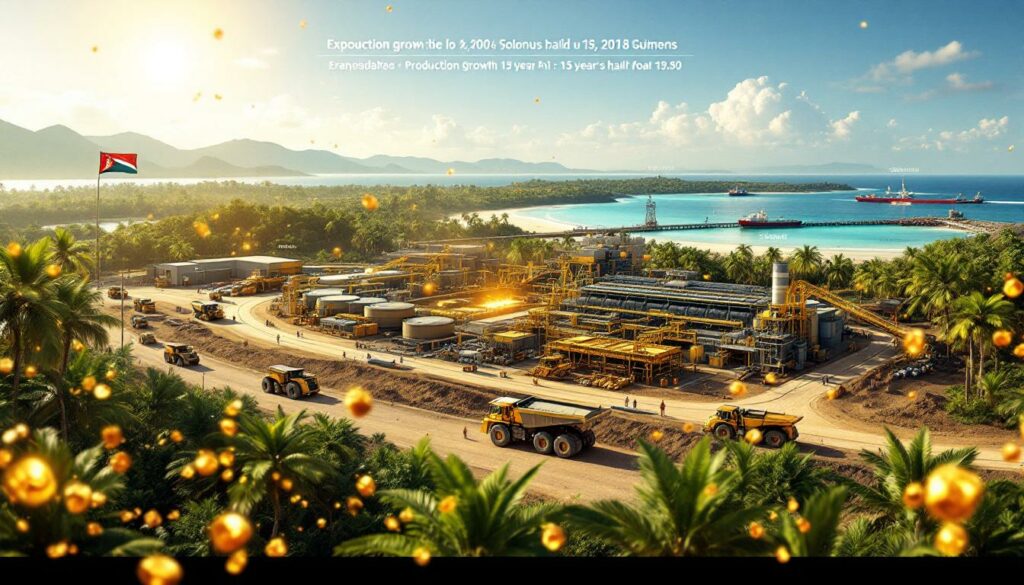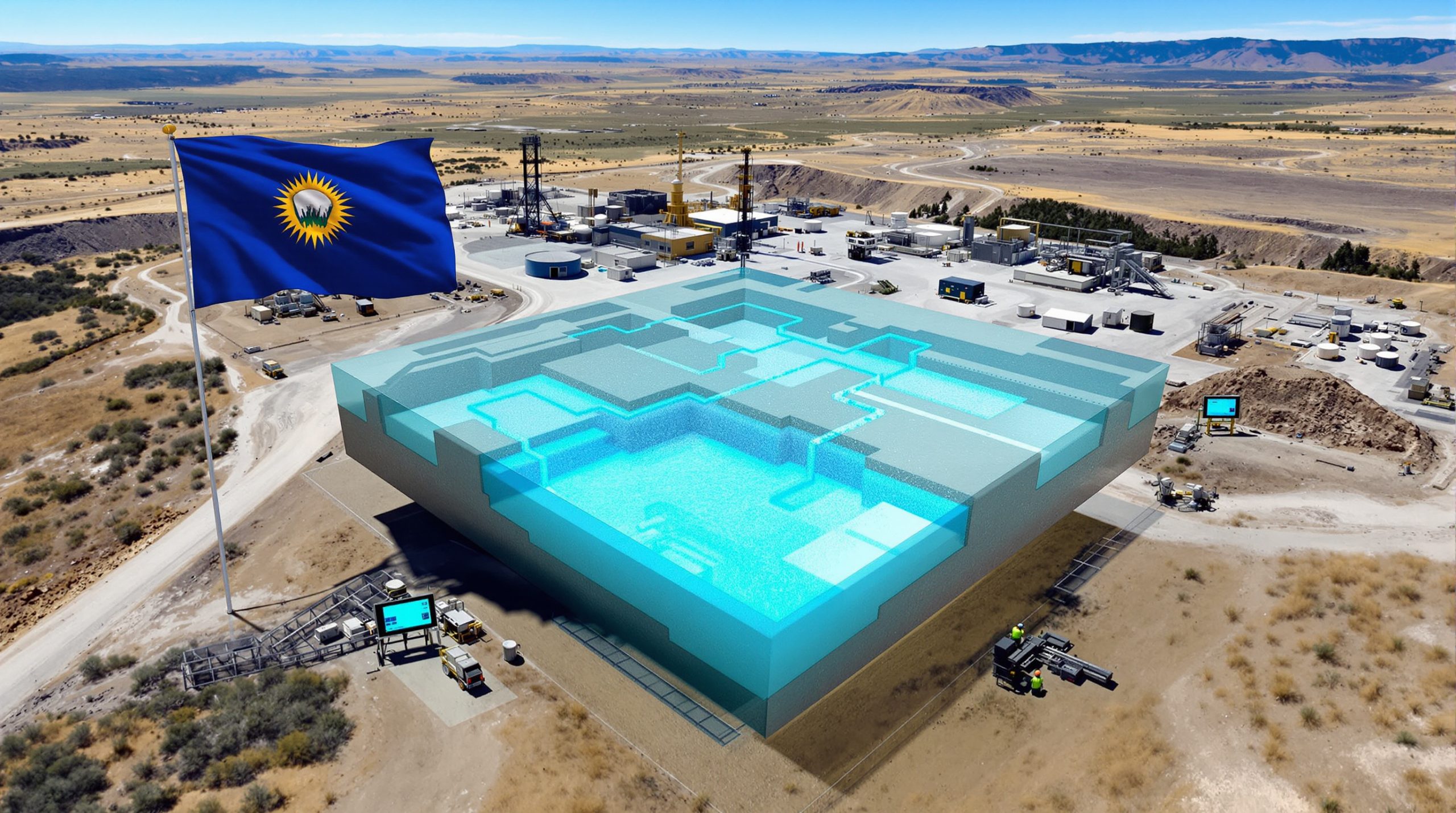What is the Simberi Gold Project Expansion?
The Simberi expansion project represents a transformative development in Papua New Guinea's mining sector, aimed at extending the operational lifespan of an established gold mine. Located on the northernmost island in the Tabar group within New Ireland province, this ambitious undertaking by St Barbara Limited (ASX: SBM) will transform the existing facility from processing oxidized ore to handling fresh sulphide material.
With a projected 13-year life-of-mine extension, the Simberi expansion demonstrates significant commitment to Papua New Guinea's mineral development sector. The project aims to leverage existing infrastructure while substantially upgrading processing capabilities to handle more challenging ore types.
Current Operations and Planned Transformation
The existing Simberi operation produces gold doré through conventional carbon-in-leach (CIL) and electrowinning processes. This traditional approach has served well for oxidized ore, which is relatively easier to process compared to sulphide material.
The expansion will introduce significant technological upgrades to handle harder, fresh ore that requires more sophisticated processing methods. This transition marks a pivotal evolution in the mining industry evolution capabilities, allowing it to process deeper, sulphide-rich ore bodies that were previously uneconomical to extract.
Strategic Importance to Papua New Guinea
As one of the significant mining developments in the region, the Simberi expansion contributes to Papua New Guinea's resource sector growth while potentially creating additional employment opportunities and economic benefits for local communities.
The project aligns with Papua New Guinea's national interest in sustainable resource development, providing long-term economic stability through extended mine life rather than short-term extraction. By implementing modern processing technologies, the expansion also raises the technical standard for mining operations in the country.
How Will the Expansion Enhance Mining Capacity?
The Simberi expansion represents a comprehensive overhaul of existing operations, with substantial increases in both mining volume and processing capabilities that will transform the site's productivity.
Mining Rate Increases
The project will nearly double the mining rate from the current 10-12 million tonnes annually to approximately 20 million tonnes per year (Mining Weekly, 2025). This significant scaling up requires not only expanded extraction capabilities but also enhanced logistics and processing infrastructure.
This increased mining rate will allow for more efficient extraction of the resource, optimizing the economics of the operation while maintaining appropriate environmental controls. The expanded capacity will support the processing of both oxide and sulphide ores during the transition period.
Processing Technology Upgrades
A key component of the expansion involves technological enhancements to handle the transition from oxidized to fresh sulphide ore:
- Addition of advanced comminution circuit modifications to process harder material
- Implementation of a new flotation circuit to produce gold-rich concentrate
- Integration with existing CIL circuit to process flotation tailings
- Development of systems to handle both concentrate production and continued doré output
These technological upgrades represent a significant advancement in processing capabilities, allowing the operation to handle more complex mineralogy while maintaining efficient gold recovery rates.
Infrastructure Developments
Supporting the expanded operations requires significant infrastructure improvements:
- Enhanced power generation facilities to meet increased energy demands
- Construction of a new wharf capable of accommodating larger vessels
- Transportation systems for moving gold concentrate to external buyers
The new wharf facility represents a particular strategic advantage, as it will enable more efficient export of concentrate and import of supplies, reducing logistical bottlenecks that could otherwise constrain production.
What Are the Economic Benefits of the Simberi Expansion?
The Simberi expansion project presents compelling economic metrics that demonstrate its potential value to stakeholders and investors across multiple financial dimensions.
Production Forecasts and Reserves
Based on proved and probable reserves, the expanded operation is projected to produce approximately 2.2 million ounces of gold from the 2026 to 2038 financial years (Mining Weekly, 2025). This represents a significant contribution to global gold supply and establishes Simberi as a mid-tier gold producer in the region.
The extended production profile provides both operational stability and financial predictability, allowing for long-term planning and investment in community development initiatives throughout the project lifecycle.
Financial Projections
The project demonstrates strong financial fundamentals:
- Net present value of $717 million (using an 8% discount rate)
- Internal rate of return of 63%
- Projected payback period of 3.6 years
These metrics indicate the expansion's potential to generate substantial returns on investment while creating long-term value for shareholders. The exceptionally strong IRR of 63% places this project among the more undervalued gold stocks developments globally, reflecting the efficiency gains from leveraging existing infrastructure.
Life-of-Mine Extension
A critical outcome of the expansion is the extension of Simberi's operational lifespan to 13 years, significantly prolonging the economic benefits flowing from the project to stakeholders, including local communities and the broader Papua New Guinea economy.
This extension provides:
- Stable employment opportunities over a longer timeframe
- Consistent revenue streams for local and national governments
- Extended community development programs
- Greater certainty for local businesses serving the operation
What Investment is Required for the Simberi Expansion?
The Simberi expansion requires substantial capital investment across multiple phases to bring the project to fruition, with carefully staged deployment to optimize returns.
Initial Capital Expenditure
The core expansion program carries an estimated initial capital cost of $235 million (Mining Weekly, 2025), covering the primary processing plant modifications, infrastructure developments, and operational enhancements.
This investment encompasses:
- Processing plant upgrades for sulphide ore treatment
- Flotation circuit installation
- Power generation capacity expansion
- Wharf construction and shipping infrastructure
Pre-Expansion Growth Capital
Between 2026 and 2027, an additional $40-60 million in pre-expansion growth capital will fund essential early works, including:
- Camp upgrades to accommodate expanded workforce
- Road construction to support increased logistics requirements
- Installation of a reverse osmosis plant for water management
This early-works phase is critical to establishing the foundation for the main expansion project, ensuring operational readiness before the primary construction phase begins.
Ongoing Operational Investments
Beyond the initial capital expenditure, the project will require ongoing investments throughout its operational life to maintain equipment, optimize processes, and adapt to changing mining conditions.
These investments typically include:
- Regular plant maintenance and equipment replacement
- Process optimization initiatives
- Environmental management systems
- Mine plan adjustments based on ongoing geological assessment
What is the Project Timeline and Current Status?
The Simberi expansion project follows a structured development timeline with several key milestones that will guide its implementation over the coming years.
Decision-Making Process
St Barbara Limited anticipates making a final investment decision in the second quarter of the 2026 financial year, potentially extending into early third quarter 2026 (St Barbara Raises $73M). This decision will trigger the main implementation phase of the expansion.
The decision timeline allows for:
- Completion of detailed engineering designs
- Finalization of contractor arrangements
- Securing of necessary permits and approvals
- Confirmation of financing arrangements
Implementation Phases
Following the final investment decision, the project will progress through several implementation phases:
- Early works (camp upgrades, road construction, reverse osmosis plant)
- Main construction phase (processing plant modifications, infrastructure development)
- Commissioning and ramp-up to full production
This phased approach minimizes operational disruption while ensuring that critical infrastructure is in place before major construction activities commence.
Technical Studies and Planning
Significant technical work has already been completed to support the expansion planning:
- Process plant studies conducted by Pitch Black Group
- Mine planning and ore reserves preparation by AMC Consultants
- Life-of-mine planning to optimize extraction sequencing and resource utilization
These technical studies provide the foundation for detailed engineering design and construction planning, ensuring that the expansion achieves its performance objectives while managing technical risks.
How Does the Expansion Affect Processing Methods?
The transition from oxide to fresh sulphide ore processing represents a fundamental technological shift for the Simberi expansion project in Papua New Guinea, requiring significant changes to processing methodology.
Current Oxide Ore Processing
The existing operation processes oxidized ore through conventional methods:
- Carbon-in-leach (CIL) circuit for gold extraction
- Electrowinning to recover gold from solution
- Production of gold doré as final product
This processing route is well-suited to oxidized ore, which typically has simpler mineralogy and requires less intensive treatment to achieve acceptable gold recovery rates.
New Sulphide Ore Processing Circuit
The expansion introduces a dual-stream processing approach:
- Enhanced comminution circuit to handle harder sulphide material
- New flotation circuit to produce gold-rich concentrate
- Continued processing of non-sulphide material through existing CIL circuit
- Dual product streams: concentrate for external processing and doré from CIL
This hybrid approach maximizes gold recovery from different ore types while managing operational complexity. The flotation circuit will target the sulphide minerals that contain gold, producing a high-grade concentrate that can be shipped to specialized processing facilities.
Technical Challenges and Solutions
Processing fresh sulphide ore presents several technical challenges that the expansion addresses:
- Increased hardness requiring more robust crushing and grinding
- Complex mineralogy necessitating flotation for optimal recovery
- Material handling systems for multiple product streams
- Water management for environmental compliance
The engineering solutions incorporate industry best practices while adapting to the specific characteristics of the Simberi ore body, ensuring optimal performance throughout the life of the operation.
What Environmental Considerations are Involved?
While specific environmental details weren't extensively detailed in the source material, mining expansions typically address several key environmental considerations that would be relevant to the Simberi project.
Water Management Systems
The planned reverse osmosis plant suggests a focus on water management, potentially addressing:
- Process water recycling to minimize consumption
- Treatment of any discharge water to meet environmental standards
- Management of seasonal rainfall variations in the tropical island setting
Water management is particularly critical in an island environment, where freshwater resources may be limited and marine ecosystems are sensitive to mining impacts. The reverse osmosis plant represents a significant investment in sustainable water management.
Tailings Management
The dual-processing approach will generate different tailings streams that require appropriate management:
- Non-sulphide tailings from the CIL circuit
- Potential acid-generating considerations for sulphide processing
- Tailings storage facility design and monitoring
Proper tailings management is essential for environmental protection and operational sustainability, particularly given the marine setting of the Simberi operation.
Energy Efficiency and Emissions
The expanded power generation facilities present opportunities to incorporate:
- Efficient generation technologies to minimize emissions
- Potential renewable energy integration where feasible
- Optimization of energy use across the expanded operation
As global mining companies increasingly focus on reducing carbon footprints, the Simberi expansion likely incorporates energy efficiency measures to align with broader sustainability objectives.
What are the Potential Community Impacts?
Mining operations in Papua New Guinea typically maintain close relationships with local communities, with several potential impact areas that the Simberi expansion will likely address.
Employment Opportunities
While specific job creation figures weren't provided in the source material, the significant expansion suggests potential for:
- Increased direct employment during construction and operation
- Skills development and training programs
- Indirect employment through local suppliers and services
The doubling of mining rate to approximately 20 million tonnes per year will require a substantial workforce increase, creating employment opportunities for local communities and broader Papua New Guinea.
Infrastructure Benefits
The development of enhanced infrastructure may provide broader community benefits:
- Improved maritime access through the new wharf facility
- Road infrastructure development
- Potential shared use of certain facilities
These infrastructure improvements can enhance connectivity for island communities, potentially reducing isolation and improving access to services and markets.
Economic Development
The extended mine life and increased production create opportunities for:
- Local business development to service the operation
- Community development initiatives
- Regional economic stability through the 13-year operational horizon
The long-term nature of the expansion provides a stable foundation for community development planning, allowing for sustained programs rather than short-term interventions.
FAQs about the Simberi Expansion Project
When will the expanded operation begin producing?
Based on the projected final investment decision timeline in Q2/Q3 of the 2026 financial year, full production would likely commence following construction and commissioning, potentially in late 2026 or early 2027. The transition from oxide to sulphide processing will be managed to maintain production continuity.
What companies are involved in developing the expansion?
St Barbara Limited owns the project, with technical support from Pitch Black Group for process plant studies and AMC Consultants for mine planning and ore reserves preparation (Mining Weekly, 2025). These specialized consulting firms bring significant expertise in their respective areas, enhancing the technical robustness of the expansion plans.
How does this expansion compare to other gold projects in the region?
The Simberi expansion represents a significant investment in Papua New Guinea's gold sector, with its 2.2 million ounce production forecast making it a substantial contributor to regional gold output. While not as large as major operations like Lihir, the project's strong financial metrics (63% IRR and 3.6-year payback) indicate exceptional economic efficiency.
What processing technology will be used for the sulphide ore?
The expansion will implement flotation technology to produce a gold-rich concentrate from sulphide ore, while continuing to process non-sulphide material through the existing carbon-in-leach circuit. This dual-stream approach optimizes gold recovery from different ore types while managing capital and operating costs effectively.
What is the expected annual gold production after expansion?
While specific annual production figures weren't provided in the source material, the total production of 2.2 million ounces over the mine life suggests an average annual production of approximately 170,000 ounces, depending on the production schedule. This would position Simberi as a mid-tier gold producer in the region.
Further Resources on Papua New Guinea Mining
For readers interested in learning more about mining developments in Papua New Guinea, additional information can be found through industry publications that regularly cover the region's resource sector. The Simberi expansion project represents an important development in PNG's ongoing resource sector growth, combining technological innovation with data-driven mining operations and sustainable development principles.
Disclaimer: This article contains forward-looking statements regarding the Simberi expansion project. Actual results may vary from projections based on market conditions, operational factors, and regulatory developments. Investors should conduct their own due diligence before making investment decisions based on this information.
Ready to Spot the Next Major Mineral Discovery?
Discover why major mineral discoveries like the Simberi Gold Project can lead to significant market returns by exploring Discovery Alert's dedicated discoveries page, powered by the proprietary Discovery IQ model that delivers real-time alerts on significant ASX mineral discoveries. Begin your 30-day free trial today at Discovery Alert to position yourself ahead of the market.




